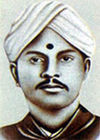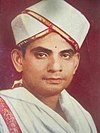Dharmasthala Temple
Legend and origin
800 years ago, Dharmasthala was known as Kuduma in Mallarmadi, then a village in Belthangady. Here lived the Jain chieftain Birmanna Pergade and his wife Ammu Ballalthi in a house called Nelliadi Beedu. According to the legend, the guardian angels of Dharma assumed human forms and arrived at Pergade's abode in search of a place where Dharma was being practised and could be continued and propagated. As was their habit, the couple hosted these illustrious visitors with all their wherewithal and great respect. Pleased by their sincerity and generosity, that night the Dharma Daivas appeared in the dreams of Pergade. They explained the purpose of their visit to him and instructed him to vacate his house for the worship of the Daivas and dedicate his life to the propagation of Dharma. Asking no questions, the Pergade built himself another house and began worshiping the Daivas at Nelliadi Beedu.
This worship of daivas continues. The Dharma Daivas again appeared before Pergade to build separate shrines to consecrate the four Daivas – Kalarahu, Kalarkayi, Kumaraswamy and Kanyakumari. Also, Pergade was instructed to choose two persons of noble birth to act as the Daivas' oracles and four worthy persons to assist Pergade in his duties as the executive head of the shrines. In return, the Daivas promised Pergade protection for his family, abundance of charity and renowned for the 'Kshetra'. Pergade, as desired, built the shrines and invited Brahmin priests to perform the rituals. These priests requested Pergade to install a Shivalinga beside the native Daivas. The Daivas then sent their vassal Annappa Swamy to procure the linga of Shiva from Kadri Manjunath Temple, near Mangalore. Subsequently, the Manjunatha temple was built around the linga.
Pergade family



The Pergade family is a Jain Bunt family who descend from the creator of the temple. Birmanna Pergade and his wife Ammu Ballalthi are the hereditary trustees of the temple. The eldest male member assumes the position of Dharma Adhikari (chief administrator) and uses the title Heggade. The Heggade was the feudal lord of the temple town and solved civil or criminal disputes. This was a judicial function and continues even to this day: The Heggade sits in judgement on hundreds of civil complaints, known as hoyulu, each day. About nearly twenty generations of the Pergade family have assumed the position of Dharma Adhikari. The present Dharma Adhikari is Veerendra Heggade. The list of previous Dharma Adhikari is as follows:
| Dharma Adhikari number | Name | From | To | |
|---|---|---|---|---|
| 1 | Varmanna Heggade (Bermanna Pergade) | |||
| 2 | Padmayya Heggade | |||
| 3 | Chandayya Heggade I | |||
| 4 | Devaraja Heggade | |||
| 5 | Manjayya Heggade I | |||
| 6 | Jinappa Heggade | |||
| 7 | Chandayya Heggade II | |||
| 8 | Devapparaja Heggade | |||
| 9 | Anantayya Heggade | |||
| 10 | Vrsabhayya Heggade | |||
| 11 | Gummanna Heggade | |||
| 12 | Varadayya Heggade | |||
| 13 | Chandayya Heggade III | |||
| 14 | Kumarayya Heggade | |||
| 15 | Chandayya Heggade IV | |||
| 16 | Manjayya Heggade II | |||
| 17 | Dharmapala Heggade | |||
| 18 | 
|
Chandayya Heggade V | 1918 C.E. | |
| 19 | 
|
Manjayya Heggade III | 1918 C.E. | 1955 C.E. |
| 20 | 
|
Ratnavarma Heggade | 1955 C.E. | 1968 C.E. |
| 21 | 
|
Veerendra Heggade | 1968 C.E. | Present |
References
- ^ David, Stephen. "Heavenly Post". India Today. Archived from the original on 2 January 2003. Retrieved 17 June 2002.
- ^ "Shiva In Mythology: Let's Reimagine The Lord". www.outlookindia.com/. 21 October 2022. Retrieved 15 November 2022.
- ^ Karnataka State Gazetteer, Part 2. Office of the Chief Editor, Karnataka Gazetteer Department, Government of Karnataka. 1983. p. 1199.
Madhwa Saint Vadirajaswamy of the Sode Matha who paid a visit to this place in the 16th century reconsecrated the linga and bestowed on the place the name Dharmasthala which was till then called Kuduma.
- ^ Saligrama Krishna Ramachandra Rao (1995). Art and Architecture of Indian Temples, Volume 3. Kalpatharu Research Academy. p. 69.
- ^ Long, Roger D; Wolpert, Stanley A. (2004). Charisma and Commitment in South Asian History. Orient Blackswan. ISBN 978-81-250-2641-9.
- ^ M. V. Kamath (1988). The Other Face of India. Konark Publishers. p. 40. ISBN 9788122000887.
In the Siva temple, the priests are Madhva brahmins—Vaishnavites—but Hegde, the dharmadhikari of all temples, is a Jain.
- ^ B. N. Hebbar (2005). The Śrī-Kṛṣṇa Temple at Uḍupi: the historical and spiritual center of the Madhvite sect of Hinduism. Bharatiya Granth Niketan. pp. 83–84. ISBN 978-81-89211-04-2.